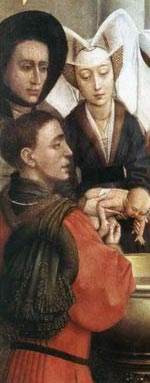Van der Weyden-an example of a chaperon in the mid 1400s
"In France in the 1600’s, when Perrault wrote his version, titled "Le Petit Chaperon Rouge," a chaperon was worn by women of aristocracy and middle class. Thus for a village girl like Little Red Riding Hood to wear a "red chaperon" made her a nonconformist. Clothing codes were strictly enforced during Perrault’s time. Thus the wearing of the red cap is one way that Perrault sets up Little Red Riding Hood as not doing what one should. It also contributes to why she is punished in the end." -From Annotations for Little Red Riding Hood, this note from Jack Zipes
This note, which I've read before, seems to contradict this from wikipedia:
"By about 1480 the chaperon was ceasing to be fashionable, but continued to be worn.[2] The size of the bourrelet was reduced, and the patte undecorated. St Joseph could, by this stage, often be seen with the evolved form. By 1500 the evolved chaperon was definitely outmoded in Northern Europe, but the original hood form still remained a useful headgear for shepherds and peasants. By this time the evolved chaperon had become fixed in some forms of civilian uniforms for lawyers, academics and the members of some knightly orders. In these uses it gradually shrank in size and often became permanently attached to the clothing underneath, effectively just as an ornament. In Italy it remained more current, more as a dignified form of headgear for older men, until about the 1520s."
(emphasis mine)
So, was Perrault's story supposed to have been set years before? In that case, red chaperons were sometimes even used to denote political affiliations. Although, the wikipedia article doesn't talk much about the chaperons as worn by women or children. I've tried doing a little digging into more of the history of fashion of the era and haven't found anything to support Zipes' statement but I hope to look into this further (please let me know in the comments if you have sources or knowledge of this topic!)
Anyway, the little girl who encounters a wolf is now famously known to English speakers as having worn a red cape with a hood, through translation differences and multiple illustrations. I had mentioned a while back that it's common for modern interpretations of LRRH to wear a red hoodie, since capes aren't typically worn any more. However, I've read that for the fashionable crowd, capes are coming back as a trend for this fall/winter season. So if you want to dress in a way that's indicative of the famous character, now would be a good time to snatch up a red cape! I personally like the versions with the faux fur around the hood, as a further tie in to the story (and Little Red's ultimate triumph over the wolf-at least in certain versions...)
Oasap $38.99
Jollychic $61
Monroe and Main $39.95
Appleseeds $89.95
Ebay $20.89
Also, if you're interested in modern fashionable interpretations of Little Red Riding Hood, style blogger The Clothes Horse has a post of inspiration pictures, including this wonderful collage:



Very interesting article! Fashion history can be more fascinating than people give it credit for. In this case I'd trustJack Zipes over Wikipedia, though.
ReplyDeleteChance has it thatat the moment I'm reading a book by Jack Zipes on Little Red Riding-Hood. Since I can't find it on his english Wikipedia page and it seems to be written with a german audience in mind, I'm afraid it only saw release in German. Here he mentions that Hans-Wolf Jäger, former professor for German at the Bremen University pointed out political connotations of the german name for Red Riding Hood "Rotkäppchen":
He argues that Ludwig Tieck in his drama "The Life and Death of little Red Riding Hood" attempted to politicize the fairy tale and picked the translation "Rotkäppchen".(little red cap) very deliberately to draw comparison to the red caps worn in remembrance of the French Revolution. Red Riding Hood is the German Youth that at first is fascinated by the ideals o the French Revolution, but then repulsed by its brutality. The hunter as a punisher who overcomes the evil (french) wolf is first introduced by Ludwig Tieck. The Grimms who were inspired by Tiecks version of the tale among others, deliberately or unwittingly adopted those political connotations.
I haven't read Tieck's drama yet, but politicizing a Romantic subject matter, especially to push an Anti-French ideoology, was quite typical of late Romanticism in Germany, so it isn't as far-fetched as it sounds.
How very interesting! Fairy tales were certainly used to promote nationalism and even as propaganda material- http://talesoffaerie.blogspot.com/2014/09/fairy-tales-in-world-war-ii.html. I've never read Tieck's drama either but that would be fascinating.
DeleteAnd yes I'd like to look into the history of Fashion in France a little more. I'm sure the situation of women's headgear is much more complex than the wikipedia summary but it would be interesting to look at it through a fashion historian's eyes instead of a folklorist!
Goodness! Who would have thought it was all so complicated - or political? :-)
ReplyDelete